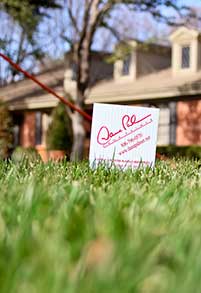
The Fescue Solution
The Fescue Solution that Dana uses is proven to transform lawns.

Partial Shaded Areas
Sunlight is the most critical part of producing a beautiful lawn. Bermuda must have 10-12 hours of full sunlight per day; anything less creates thinness, which results in exposed dirt and increased weeds. If your lawn was originally Bermuda, it probably looked great for the first 10-15 years then weeds started to become a problem. It is time to think about a change.
Celebration Bermuda
I have recommended this more shade-tolerant Bermuda to several customers; however, it must have at least 6 hours of full direct sun per day and still requires as much water as Fescue under trees.
Discovery Bermuda
This is a new variety that is being put in new homes in full sun. it is being promoted as “no-mow” but that also means “no-grow”. It is my opinion that this Bermuda should be in areas with 25-41 inches of rain per year, not in our area. If you are putting in a new Bermuda lawn, use Tifton 10, Celebration, of Tifton 419. These all survived better than Buffalo in the drought years and had fewer weeds.
Shadow Turf
This grass will require 4-6 years to cover in heavy shade plus requires as much water as Fescue to stay alive under trees.
Older Hybrid Bermuda
This Bermuda seems to have separated into different grass types due to time and moisture stress. Over-seeding with Fescue is a great solution.
October is the most successful month to establish new fescue lawns or to over-seed existing lawns.
 Spring seeding is extremely difficult due to:
Spring seeding is extremely difficult due to:
-
- High winds
- Difficulty in controlling weeds and trying to germinate grass seed
- Fall-seeded lawns will have a 3 foot root system by June, whereas spring-seeded lawns will be very immature
- Heavy watering that is required in May to keep the new grass alive will create disease.
Spring Dead Spot disease in Bermuda lawns
Go to the Helpful Tips page, then scroll down to the research paper from Oklahoma State University on Spring Dead Spot for the most current information on the type of disease found in our area. Currently there is not a fungicide solution to this problem. The best solution I have found is over-seeding the turn with Fescue. Fescue is not susceptible to Spring Dead Spot, thus the problem goes away and the lawn looks fantastic all year long. This disease attacks the Bermuda during cool fall temperatures. High spring and summer heat suppresses the disease. A temporary solution that will speed recovery is to apply group peat moss or potting soil about 1 inch deep in the infected spots. The peat moss will degrade during the summer, which will acidify the soil Ph. This disease occurs in areas of the United States where soils are alkaline, like the Lubbock area. These products, which are available in nurseries, help reduce the soil pH which discourages this disease. Any extra product can be put into the flowerbeds to enrich those areas.
Estimates
You can contact me now through my Request Estimate page or Contact page to let me know if you want me to consult with you. If I seeded your lawn the previous year, you do not need to contact me. Your lawn will be automatically scheduled for seeding the following year.
Cost
Initial conversions to Fescue will cost more due to the aggressive seeding technique that is required, along with the heavy seed and mulch needed. A front and back lawn of an average home, 3500 sq ft, would cost $533.27. Maintenance seeding is usually 25-30% less.
© 2021 Dana Palmer |Web Design by GriffinWink Advertising
